 |
Please note : There are lots of large pictures on this page
That may take some time to download if using a dial up connection.
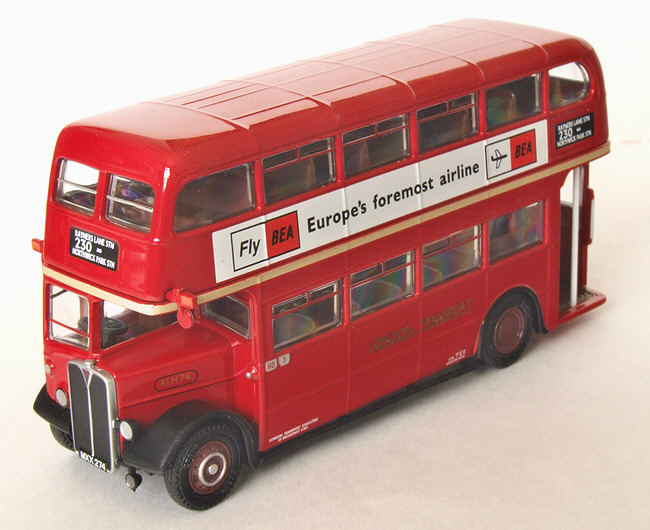
34201 RLH74 the Lowbridge Weymann bodied AEC Regent III
|
A Brief History
The RLH Class
The RLH classes' existence could be put down to good fortune rather than planning. Midland General had ordered thirty low bridge Weymann bodied AEC Regent III's but found that they only actually needed 10 of the buses for their operational requirements, thus London Transport snapped up the remaining 20 to replace some of its aging fleet of ST & STL lowbridge vehicles. The new vehicles RLH1-20 (KYY 501-520) entered service during the summer of 1950 and all were painted green for use in the Country Area where they were allocated to three garages Godstone, Addlestone & Amersham.
The vehicles were considered a success and a further batch of 56 vehicles RLH21-76 (MXX221-276) were ordered by London Transport and delivered during the last three months of 1952. Although these RLH2 type were very similar to the first 20 (RLH1 type) they had a number of minor detailing changes which included the removal of the prominent roof ventilators and the use of polished aluminium instead of chrome on the radiator surround.
On the rear there was the addition of arrow type indicators above the number plate and a used ticket box on the platform bulkhead. The original batch of 20 were fitted Routemaster style rear light clusters later in their life.
The second batch were split between the central and country divisions with 24 red and 32 green examples, these were put to work on remaining lowbridge routes replacing all the remaining lowbridge ST & STL class vehicles. A list of the RLH routes can be found below.
Between 1955 & 1959 eight green examples were repainted red and passed to the central area for two new routes the 178 and 248, however the red allocation was tight and during overhaul cycles green examples were often loaned to Dalston, Hornchurch and Harrow Weald to cover for their red sisters.
The end of the RLH era started in 1964 when the country area 410 route was diverted to avoid the low bridge in Oxted and converted to RT. Other routes were converted to single deck operation as passenger numbers reduced. The 230 route became the first of the red routes to disappear being replaced by AEC Merlin operated route H1 in 1969.
17 green RLH buses were transferred to London Country in January 1970 but these only remained in service for a further seven months before being replaced on mass by new single deck AEC Swifts.
The last red RLHs were withdrawn from route 178 in April 1971 beginning to an end 21 years of LT service service.
The cast off RLHs proved popular however, their low height design making them particularly ideal for use in the USA which was eventually the new home for nearly half of the class.
Several examples have been preserved in the UK in both the red & green livery, a number of vehicles have also been used as heritage vehicles with both Timebus & Ensignbus operating red examples.
A more detailed history of the RLH class complete with individual vehicle histories can be found at Ian's Bus Stop.
|
|
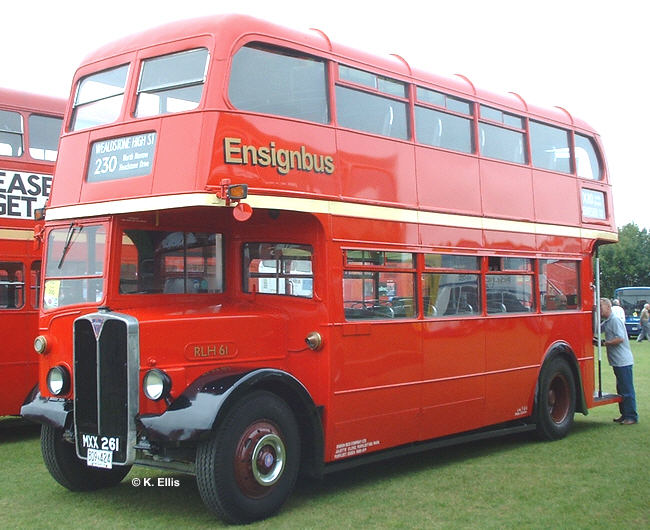
Ensignbus RLH61 at Showbus 2005
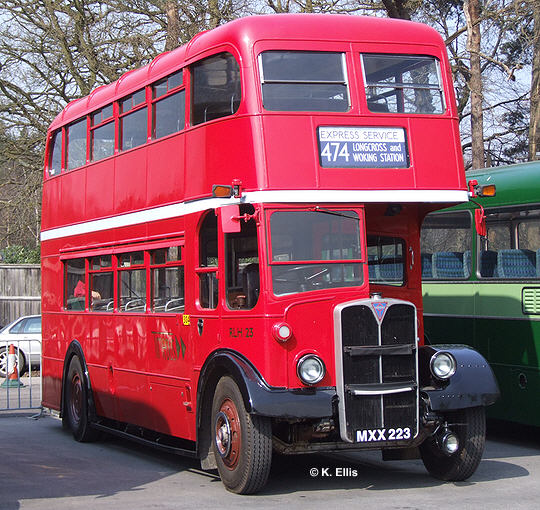
Timebus RLH23 at the 2007 Cobham Bus Museum Gathering
|
| The Model
The model is clearly based on the later second batch of vehicles and lacks the roof vents found on the first 20 vehicles.
The models construction is classic EFE and uses the now familiar internal poles, the upper and lower deck body are die-cast while the chassis and front mudguards are plastic as are the platform bulkhead and internal seating components.
|
|
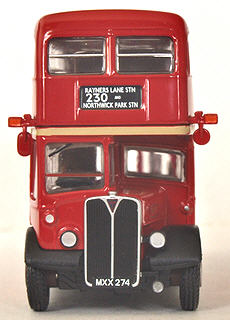 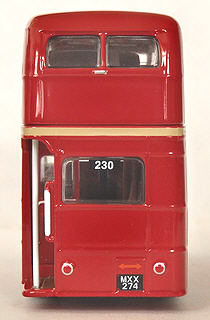
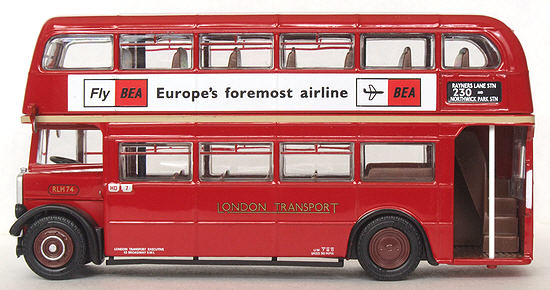
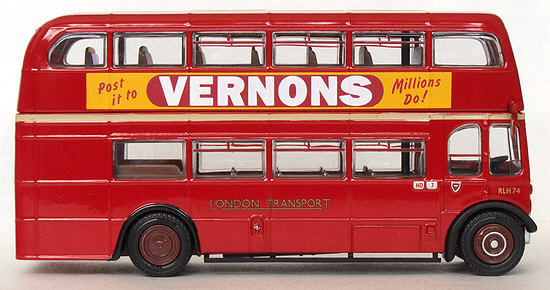
|
|
The model seems to catch the spirit of the real bus extremely well, the proportions and subtle body curves all look pretty accurate. The body panel beading has been modeled in it entirety, the artificial gaps that are often found on earlier EFE models around areas where fleet names and advert are positioned are not present on the RLH and this really improves the models appearance.
Window are flush fitting and have vents which are finely cast onto the glazing, these have been delicately picked out with red paint on the side and cab windows.
The model is fitted with front traffic indicator stalks which incorporate the driving mirrors, these are well detailed and a great improvement over those fitted to the Routemaster models. The positioning of these is however slightly too high but this isn't really that obvious and they do look to be in proportion with the rest of the model.
|
|

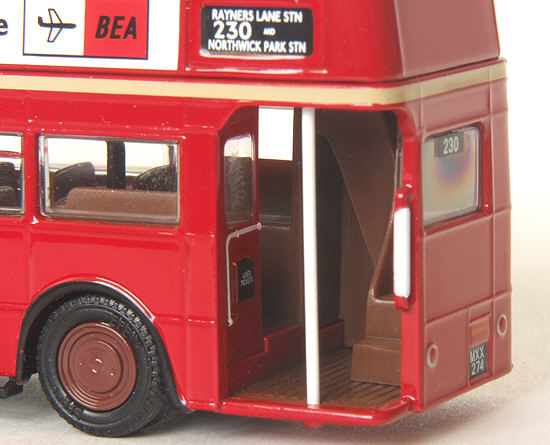
|
|
The rear platform and bulkhead are of a similar construction to that used on the Routemasters, internally the seating and staircase are single piece plastic components, although on the lower deck the seat back grab rails have been carefully picked out with silver paint. The lower deck ceiling which is finished in cream features the sunken off-side upper deck gangway and also includes panel beading and light fittings.
The platform grab pole and rear grab handle do appear somewhat heavy especially when compared to the finely detailed grab rail present on the platform bulkhead, the platform pole could also be improved if the white area was reduced and the didn't extended the full length of the pole.
|
|
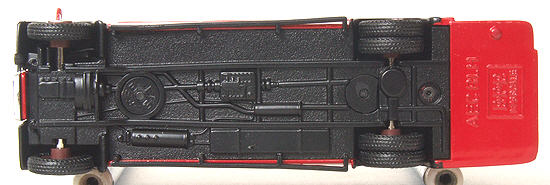
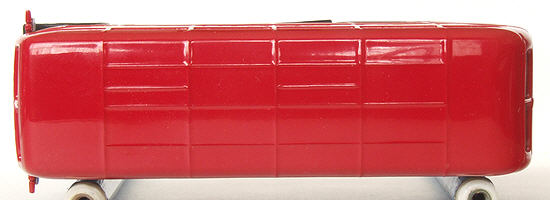
|
|
The base reveals a three quarter length plastic base plate on to which have been moulded some of the basic chassis details. The rear most quarter under the platform is cast in metal and this has the legend A.E.C. RLH and an EFE logo stamped across it.
The tampo printing is finely applied with nicely scaled gold fleet names which are outlined in black. Two different period side adverts for BEA & Vernons are carried while tiny legal lettering and weight information appears on the lower near side panels.
Silver garage codes showing HD 7 are carried in the correct positions on each side of the bus while on the front a tiny AEC badge is reproduced on the plastic radiator along with a crisp registration number.
The near side bonnet fleet number plate is applied as a printed feature rather than being moulded but this will probably allow some none London vehicles to be produced in the future which didn't have these.
All the lights are picked out with silver paint on the front as is the off-side fuel filler cap and driver's cab door handle. The rear reflectors have a silver surround and red centre which is very neatly done. It's a shame the two small red tail lights that should be present between the rear number plate and orange direction arrows haven't been reproduced on the model.
|
|

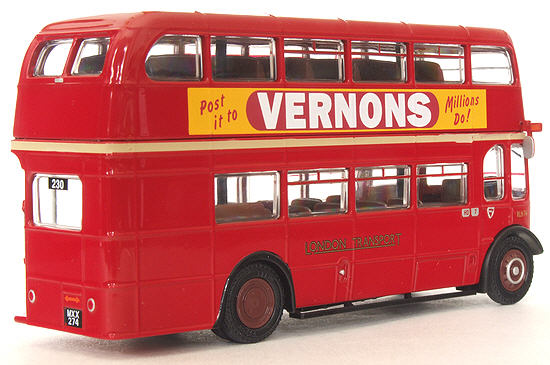
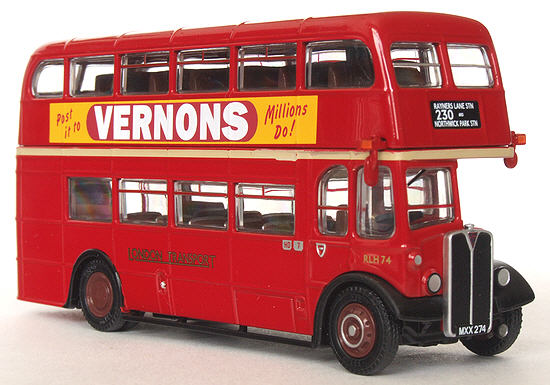
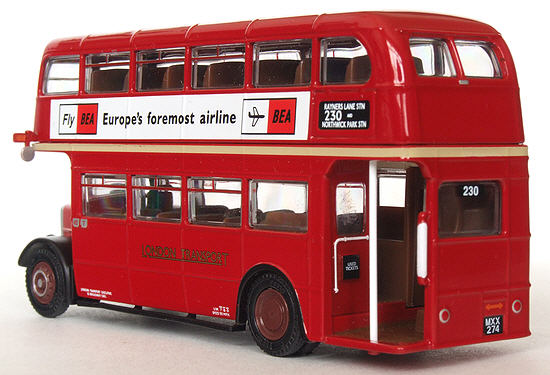
|
|
This model certainly seems to be a step in the right direction and shows EFE are still capable of producing attractive models which capture the essence of the real vehicles. This is without doubt one of the best detailed EFE buses to date and has addressed many of the criticisms which were leveled at the Routemasters released in 2006.
|
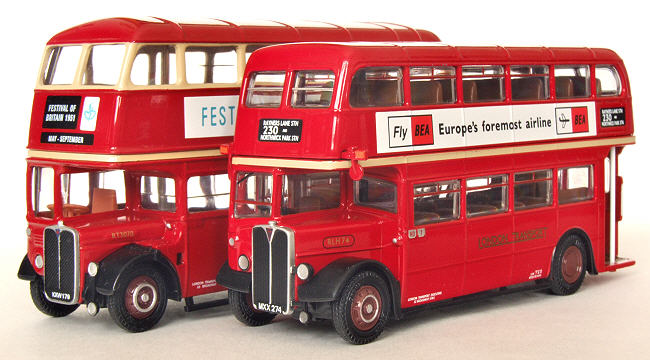
The difference in height between the RT & RLH can clearly be seen in this shot.
|
| The London Transport RLH Routes
Central Area
127 Morden Station - South Wimbledon
152 Feltham - Merton
178 Clapton Pond - Stratford
230 Rayners Lane - Northwick Part Station
230A Harrow Weald Garage - Northwick Park Station
248 Upminster - Cranham
248A Upminster Station and Corbets Tey
249 Corbets Tey - Upminster Station
252 Romford Station - Collier Row
Country Area
305 Uxbridge - High Wycombe
336 Berkhamsted - Watford
359 Amersham - Aylesbury
408A Guildford - Merrow
410 Reigate - Bromley North Station
415 Ripley - Guildford
420 Woking Station- West Byfleet
424 East Grinstead - Reigate
428 East Grinstead - Dormansland
436 Guildford - Staines
436A Ripley - Staines
447 Redhill - South Merstham
461 Walton-on-Thames - Staines
461A Ottershaw - Botleys Park
462B Walton-on-Thames - Weybridge BAC Works
462C Staines - Addlestone
463 Walton-on-Thames - Guildford
|
|
| Model Review Index |
|
















